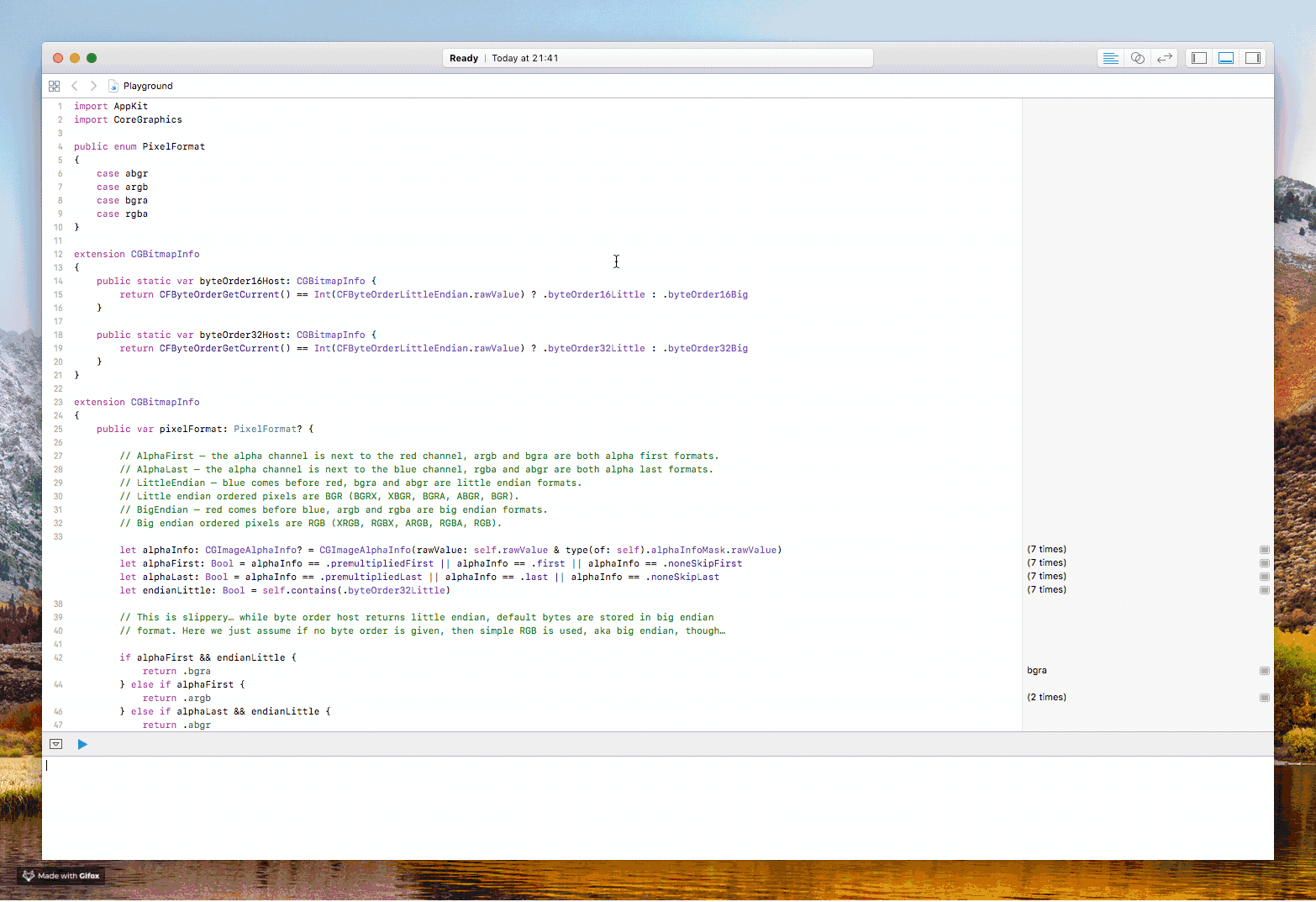Getting pixel format from CGImage
Some years later and after testing my findings in production I can share them with good confidence, but hoping someone with theory knowledge will explain things better here? Good places to refresh memory:
- Wikipedia: RGBA color space – Representation
- Apple Lists: Byte Order in CGBitmapContextCreate
- Apple Lists: kCGImageAlphaPremultiplied First/Last
Based on that you can use following extensions:
public enum PixelFormat
{
case abgr
case argb
case bgra
case rgba
}
extension CGBitmapInfo
{
public static var byteOrder16Host: CGBitmapInfo {
return CFByteOrderGetCurrent() == Int(CFByteOrderLittleEndian.rawValue) ? .byteOrder16Little : .byteOrder16Big
}
public static var byteOrder32Host: CGBitmapInfo {
return CFByteOrderGetCurrent() == Int(CFByteOrderLittleEndian.rawValue) ? .byteOrder32Little : .byteOrder32Big
}
}
extension CGBitmapInfo
{
public var pixelFormat: PixelFormat? {
// AlphaFirst – the alpha channel is next to the red channel, argb and bgra are both alpha first formats.
// AlphaLast – the alpha channel is next to the blue channel, rgba and abgr are both alpha last formats.
// LittleEndian – blue comes before red, bgra and abgr are little endian formats.
// Little endian ordered pixels are BGR (BGRX, XBGR, BGRA, ABGR, BGR).
// BigEndian – red comes before blue, argb and rgba are big endian formats.
// Big endian ordered pixels are RGB (XRGB, RGBX, ARGB, RGBA, RGB).
let alphaInfo: CGImageAlphaInfo? = CGImageAlphaInfo(rawValue: self.rawValue & type(of: self).alphaInfoMask.rawValue)
let alphaFirst: Bool = alphaInfo == .premultipliedFirst || alphaInfo == .first || alphaInfo == .noneSkipFirst
let alphaLast: Bool = alphaInfo == .premultipliedLast || alphaInfo == .last || alphaInfo == .noneSkipLast
let endianLittle: Bool = self.contains(.byteOrder32Little)
// This is slippery… while byte order host returns little endian, default bytes are stored in big endian
// format. Here we just assume if no byte order is given, then simple RGB is used, aka big endian, though…
if alphaFirst && endianLittle {
return .bgra
} else if alphaFirst {
return .argb
} else if alphaLast && endianLittle {
return .abgr
} else if alphaLast {
return .rgba
} else {
return nil
}
}
}
Note, that you should always pay attention to colour space – it directly affects how raw pixel data is stored. CGColorSpace(name: CGColorSpace.sRGB) is probably the safest one – it stores colours in plain format, for example, if you deal with red RGB it will be stored just like that (255, 0, 0) while device colour space will give you something like (235, 73, 53).
To see this in practice drop above and the following into a playground. You'll need two one-pixel red images with alpha and without, this and this should work.
import AppKit
import CoreGraphics
extension CFData
{
public var pixelComponents: [UInt8] {
let buffer: UnsafeMutablePointer<UInt8> = UnsafeMutablePointer.allocate(capacity: 4)
defer { buffer.deallocate(capacity: 4) }
CFDataGetBytes(self, CFRange(location: 0, length: CFDataGetLength(self)), buffer)
return Array(UnsafeBufferPointer(start: buffer, count: 4))
}
}
let color: NSColor = .red
Thread.sleep(forTimeInterval: 2)
// Must flip coordinates to capture what we want…
let screen: NSScreen = NSScreen.screens.first(where: { $0.frame.contains(NSEvent.mouseLocation) })!
let rect: CGRect = CGRect(origin: CGPoint(x: NSEvent.mouseLocation.x - 10, y: screen.frame.height - NSEvent.mouseLocation.y), size: CGSize(width: 1, height: 1))
Swift.print("Will capture image with \(rect) frame.")
let screenImage: CGImage = CGWindowListCreateImage(rect, [], kCGNullWindowID, [])!
let urlImageWithAlpha: CGImage = NSImage(byReferencing: URL(fileURLWithPath: "/Users/ianbytchek/Downloads/red-pixel-with-alpha.png")).cgImage(forProposedRect: nil, context: nil, hints: nil)!
let urlImageNoAlpha: CGImage = NSImage(byReferencing: URL(fileURLWithPath: "/Users/ianbytchek/Downloads/red-pixel-no-alpha.png")).cgImage(forProposedRect: nil, context: nil, hints: nil)!
Swift.print(screenImage.colorSpace!, screenImage.bitmapInfo, screenImage.bitmapInfo.pixelFormat!, screenImage.dataProvider!.data!.pixelComponents)
Swift.print(urlImageWithAlpha.colorSpace!, urlImageWithAlpha.bitmapInfo, urlImageWithAlpha.bitmapInfo.pixelFormat!, urlImageWithAlpha.dataProvider!.data!.pixelComponents)
Swift.print(urlImageNoAlpha.colorSpace!, urlImageNoAlpha.bitmapInfo, urlImageNoAlpha.bitmapInfo.pixelFormat!, urlImageNoAlpha.dataProvider!.data!.pixelComponents)
let formats: [CGBitmapInfo.RawValue] = [
CGImageAlphaInfo.premultipliedFirst.rawValue,
CGImageAlphaInfo.noneSkipFirst.rawValue,
CGImageAlphaInfo.premultipliedLast.rawValue,
CGImageAlphaInfo.noneSkipLast.rawValue,
]
for format in formats {
// This "paints" and prints out components in the order they are stored in data.
let context: CGContext = CGContext(data: nil, width: 1, height: 1, bitsPerComponent: 8, bytesPerRow: 32, space: CGColorSpace(name: CGColorSpace.sRGB)!, bitmapInfo: format)!
let components: UnsafeBufferPointer<UInt8> = UnsafeBufferPointer(start: context.data!.assumingMemoryBound(to: UInt8.self), count: 4)
context.setFillColor(red: 1 / 0xFF, green: 2 / 0xFF, blue: 3 / 0xFF, alpha: 1)
context.fill(CGRect(x: 0, y: 0, width: 1, height: 1))
Swift.print(context.colorSpace!, context.bitmapInfo, context.bitmapInfo.pixelFormat!, Array(components))
}
This will output the following. Pay attention how screen-captured image differs from ones loaded from disk.
Will capture image with (285.7734375, 294.5, 1.0, 1.0) frame.
<CGColorSpace 0x7fde4e9103e0> (kCGColorSpaceICCBased; kCGColorSpaceModelRGB; iMac) CGBitmapInfo(rawValue: 8194) bgra [27, 13, 252, 255]
<CGColorSpace 0x7fde4d703b20> (kCGColorSpaceICCBased; kCGColorSpaceModelRGB; Color LCD) CGBitmapInfo(rawValue: 3) rgba [235, 73, 53, 255]
<CGColorSpace 0x7fde4e915dc0> (kCGColorSpaceICCBased; kCGColorSpaceModelRGB; Color LCD) CGBitmapInfo(rawValue: 5) rgba [235, 73, 53, 255]
<CGColorSpace 0x7fde4d60d390> (kCGColorSpaceICCBased; kCGColorSpaceModelRGB; sRGB IEC61966-2.1) CGBitmapInfo(rawValue: 2) argb [255, 1, 2, 3]
<CGColorSpace 0x7fde4d60d390> (kCGColorSpaceICCBased; kCGColorSpaceModelRGB; sRGB IEC61966-2.1) CGBitmapInfo(rawValue: 6) argb [255, 1, 2, 3]
<CGColorSpace 0x7fde4d60d390> (kCGColorSpaceICCBased; kCGColorSpaceModelRGB; sRGB IEC61966-2.1) CGBitmapInfo(rawValue: 1) rgba [1, 2, 3, 255]
<CGColorSpace 0x7fde4d60d390> (kCGColorSpaceICCBased; kCGColorSpaceModelRGB; sRGB IEC61966-2.1) CGBitmapInfo(rawValue: 5) rgba [1, 2, 3, 255]

Could you use NSBitmapFormat?
I wrote a class to source color schemes from images, and that's what I used to determine the bitmap format. Here's a snippet of how I used it:
var averageColorImage: CIImage?
var averageColorImageBitmap: NSBitmapImageRep
//... core image filter code
averageColorImage = filter?.outputImage
averageColorImageBitmap = NSBitmapImageRep(CIImage: averageColorImage!)
let red, green, blue: Int
switch averageColorImageBitmap.bitmapFormat {
case NSBitmapFormat.NSAlphaFirstBitmapFormat:
red = Int(averageColorImageBitmap.bitmapData.advancedBy(1).memory)
green = Int(averageColorImageBitmap.bitmapData.advancedBy(2).memory)
blue = Int(averageColorImageBitmap.bitmapData.advancedBy(3).memory)
default:
red = Int(averageColorImageBitmap.bitmapData.memory)
green = Int(averageColorImageBitmap.bitmapData.advancedBy(1).memory)
blue = Int(averageColorImageBitmap.bitmapData.advancedBy(2).memory)
}